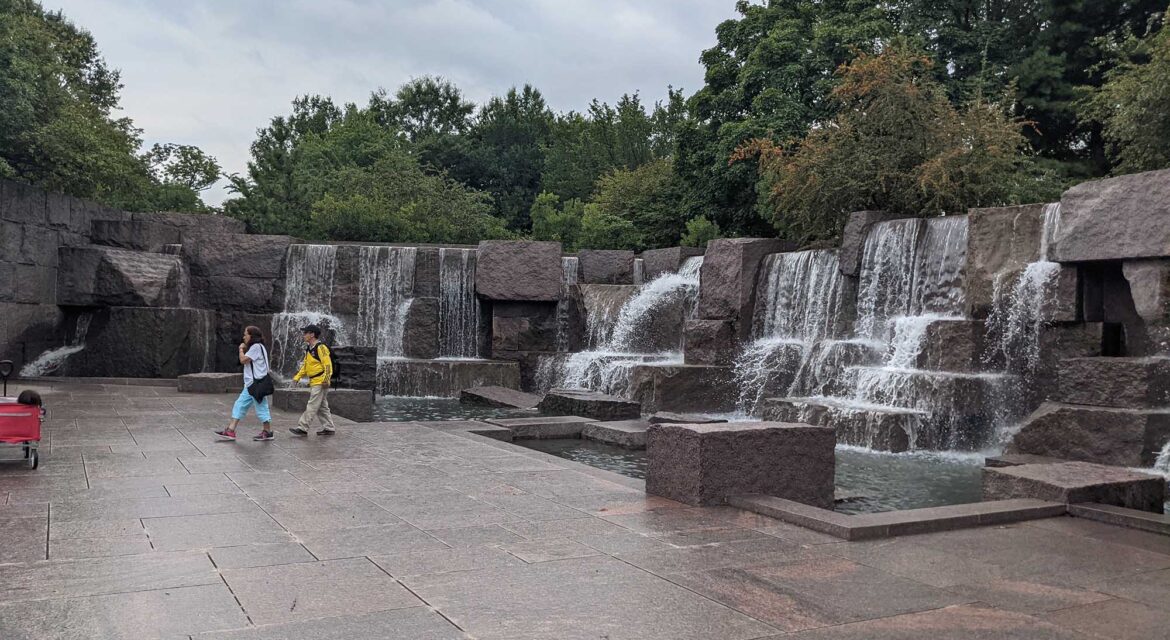 Dedicated to the President of the United States during World War II, the Franklin Delano Roosevelt Memorial in Washington D.C. allows audiences to see and experience the entire era he represents. Using elements of stone, water, and distinctive landscaping, the memorial defines the space in a way that takes visitors through the story of America during the years of FDR’s Presidency, highlighting how many different ways monuments can enable engagement for individuals and audiences across the eras.
Dedicated to the President of the United States during World War II, the Franklin Delano Roosevelt Memorial in Washington D.C. allows audiences to see and experience the entire era he represents. Using elements of stone, water, and distinctive landscaping, the memorial defines the space in a way that takes visitors through the story of America during the years of FDR’s Presidency, highlighting how many different ways monuments can enable engagement for individuals and audiences across the eras.

Experiencing American History
 Franklin Delano Roosevelt served as the 32nd President of the United States which saw him lead the country through the Great Depression and World War II. An effort to commemorate his legacy and contributions began soon after his death in 1945. The site was dedicated as the Franklin Delano Roosevelt Memorial Park in 1969 and the memorial was authorized in 1982 but not completed until 1997.
Franklin Delano Roosevelt served as the 32nd President of the United States which saw him lead the country through the Great Depression and World War II. An effort to commemorate his legacy and contributions began soon after his death in 1945. The site was dedicated as the Franklin Delano Roosevelt Memorial Park in 1969 and the memorial was authorized in 1982 but not completed until 1997.
The Franklin Delano Roosevelt Memorial allows audience to experience twelve years of American History through a sequence of four outdoor rooms, with each one devoted to one of Roosevelt’s four terms as President. Animated by water, stone and sculpture, each of these spaces have numerous features that reflect the economic depression and world war that he guided the country through.
The first room introduces FDR’s first term as president, while the second highlights the challenges FDR faced with his New Deal programs in the midst of the economic depression. An open area between the second and third rooms symbolizes the march to war, while the third room highlights the destruction that World War II caused across the world. Since FRD died early into his fourth term, the fourth room features a still pool of water and a low-relief panel showing FDR’s funeral procession down Pennsylvania Avenue.
Dedicated in 1997, the Franklin Delano Roosevelt Memorial allows audiences to connect with an essential element of American history but those connections are enabled by specific features across the entire space.

Features that Enable Connections
 Spread across seven and a half acres, which also includes waterfalls and naturally beautiful scenery, all of the elements in the memorial have a thematic connection to the history and legacy of FDR. Waterfalls become larger and more complex from one room to the next, reflecting the increasing complexity of a presidency marked by the vast upheavals of economic depression and world war.
Spread across seven and a half acres, which also includes waterfalls and naturally beautiful scenery, all of the elements in the memorial have a thematic connection to the history and legacy of FDR. Waterfalls become larger and more complex from one room to the next, reflecting the increasing complexity of a presidency marked by the vast upheavals of economic depression and world war.
Additionally, the memorial features numerous sculptures and individual monuments. One sculpture shows a line of men waiting for free bread in a city setting. Nearby is a piece that shows a farmer and his wife which represent the struggles the American farmer experienced in the 1930s. Another depicts a man sitting by his radio, listening to one of the many “fireside chats” that Roosevelt used to communicate directly with Americans.
A bronze statue of First Lady Eleanor Roosevelt standing before the United Nations is the only presidential memorial to depict a First Lady. A large sculpture of President Roosevelt with his dog Fala is the largest depiction of FDR on the site. In 2001, an additional statue was placed near the memorial entrance showing FDR seated in a wheelchair much like the one he actually used during his life, even though this fact was never publicized.
The Franklin Delano Roosevelt Memorial store features numerous products for sale that are connected to the physical monument as well as the legacy of FDR. The memorial is also an essential element of tours and maps that serve visitors who come from around the world to experience the memorial.
The Franklin Roosevelt Memorial itself has drawn approximately 3.3 million visitors in a single year, highlighting what it can mean when history isn’t something that is merely on display but is instead something that audiences of all types can experience on multiple levels.

Engagement and Experiences
 Numerous monuments across Washington D.C. honor individual presidents and national legacies in a monumentous way but few allow audiences to experience an entire era while still being directly connected to either kind of legacy. The Franklin Delano Roosevelt Memorial has been able to achieve this kind of connection thanks to the engagement that has been enabled for audiences across the entire space, helping to cultivate interest that spans entire generations of people and eras of time.
Numerous monuments across Washington D.C. honor individual presidents and national legacies in a monumentous way but few allow audiences to experience an entire era while still being directly connected to either kind of legacy. The Franklin Delano Roosevelt Memorial has been able to achieve this kind of connection thanks to the engagement that has been enabled for audiences across the entire space, helping to cultivate interest that spans entire generations of people and eras of time.

